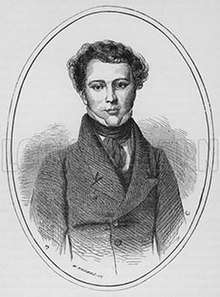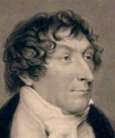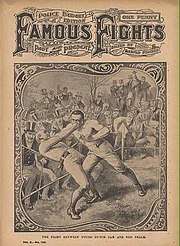Young Dutch Sam
Young Dutch Sam (30 January 1808 – 4 November 1843) was an English professional bare-knuckle boxer, who fought during the sport's "pioneer era" (pre-1892). He was considered a bare-knuckle welterweight champion of England during his career, and was an inductee of the International Boxing Hall of Fame in 2002.
| Young Dutch Sam | |
|---|---|
 Evans around 20 years of age | |
| Statistics | |
| Real name | Samuel Evans |
| Nickname(s) | "The Phenomenon" |
| Weight(s) | Welterweight averaged 137-45 lb (62.1-65.7K) in early career Fought around 152 lb (68.9K) at end of career[1] |
| Height | 5 ft 9 in (1.75 m) |
| Nationality | British |
| Born | January 30, 1808 Well Street, Ratcliffe Highway, East End, London, England |
| Died | November 4, 1843 (aged 35) West End London, England, Kensal Green Cemetery |
| Stance | Orthodox;right-handed |
| Boxing record | |
| Wins | 16[2] (Estimate) |
| Losses | 0 |
Early life
Young Dutch Sam was born Samuel Evans on 30 January 1808 on Well Street, Ratcliffe Highway in London's East End, a handsome son[1] of the Jewish bare-knuckle English boxing champion Samuel Elias known as Dutch Sam. His father was of fairly recent Dutch heritage. According to a few accounts, particularly the 1904 volume, Famous Fights Past and Present[3], he may well have been an illigitimate child, born out of wed-lock, though his mother, not his father's parentage was in question. Ratcliffe Highway was considered a poorer section of London, and known for robberies in London's early nineteenth century, most notably around 1810.[4][5] In his earliest days, Young Dutch worked as a shop boy in a potato warehouse, and later as a press boy and sheet folder for the printing presses of Pierce Egan. He was also a marker at the King's Bench Racket-ground, where he earned to play the game with science and skill, rivaling the greatest players of his era. Most important in his youth, was Young Dutch's work for Egan, the early boxing journalist and publisher. Evans also worked as a "runner" distributing Egan's weekly newspaper Pierce Egan's Life, in London to sports fans in pubs.

Through Egan, Sam met boxing Hall of Famer and English bare-knuckle heavyweight champion John Jackson, known as Gentleman Jackson, who years before had beaten the Jewish former English champion Daniel Mendoza, at whose academy Young Dutch may have also studied. Not long after meeting Jackson, Sam left the newspaper business to make a living in the prize ring.[2] His boxing skills were honed under the tutelage of Richard Curtis, an exceptional hard hitting bare-knuckle boxer of the period, who often acted as his advisor and boxing second in important matches.[1]
Sam's first benefit fight, considered a sparring exhibition, was at Old Five's Court on Saint Martin's Lane, an historic London location, where his considerable skill was noted.[1] Old Five was a racquet sport of the period.
Pro career
Sam won his first fight at age 15 against Bill Dean, and went on to defeat Ned Stockham, Harry Jones, Tom Cooper, Jack Cooper, Dick Davis and Ned Neale among others before retiring undefeated.[6] Young Dutch displayed a mixture of power and speed in the ring, yet he had the ability to inflict serious punishment, notably the strong left jab he used to soundly defeat Gypsy Cooper in 1826.
Around this time, Hughes Ball a wealthy, and socially distinguished boxing devotee of the era, became Sam's patron. By 1829, Hughes Ball was forced to flea from England to France, as a result of excessive gambling debts, though he returned to England by 1834.[7]
Sam was married in 1823, according to London's Morning News, and obtained some property with the marriage. By 1826, he was working as a Publican or bar keeper on Blackmon Street.[4]
Victories over Harry Jones, and Tom "Gypsey" Cooper
By some accounts, at least according to the boxing site Boxrec, his victory over Harry Jones, known as the "Sailor Boy", at Shere Mere on 18 October 1825 cemented his informal title of English or World bareknuckle welterweight champion, though no sanctioning bodies at the time could officially bestow this title. Though questionable, the writer for the 1904 publication Famous Fights Past and Present, wrote that Sam's fight with Jones was a pre-arranged match and that Jones had decided to throw the fight.[8][7] Both Jones and Sam were well known boxers at the time. Jones appeared more muscular and likely stronger, though Young Dutch was noticeably the taller of the two competitors. The match was fought in the rain, and the well known bare-knuckle boxer Dick Curtis was Young Dutch's second. In the tenth round Jones caught Sam around the neck and threw him to the ground. This tactic, known as fibbing, would be illegal using today's Marquess of Queensbury rules. The last blow in the 18th round was a right to the jaw, which ended the match in 53 minutes, as Jones did not wish to continue when his seconds attempted to lift him. The reporter for London's Morning Chronicle wrote that Jones showed less aggression in the final rounds, where Young Dutch Sam took the lead in the fighting. Tellingly, Jones was frequently down which ended rounds thirteen through fifteen.[9] The purse was set for £25 a side, a considerable sum, for an early career match.[10]
In a bout with Tom "Gypsey" Cooper in Gravesend in Essex close to the Thames on 25 April 1826, Sam was a clear winner in an eighteen round bout according to the Boxing Register, though London's Morning Post listed the match as lasting 5 rounds. The more detailed London Morning Chronicle listed the action in 15 rounds, a far more accurate tally. Sam was the favorite in the betting at 2-1, for an early career purse of £30 a side. Gypsey Cooper was the brother of Jack Cooper who attended him at the match. Sam took a clear lead, landing a right and left to Gypsey's mouth in the first that floored him, and floored Cooper again with a right and left at the end of the third. In the sixth, Sam showed his ability to rush away from the blows of his opponents, as he had in earlier rounds. In the tenth through the fifteenth Sam dominated, badly punishing his opponent.[2][11] Sam's habit of drawing his man to him, and then taking advantage of the closeness to punch with accuracy echoed the scientific boxing style of his primary mentor Dick Curtis. Gypsey Cooper, though a stouter and somewhat more muscular opponent, left his head unguarded during his mad rushes which gave Young Dutch the opportunity to frequently connect with blows to this vital spot.[12]
On 8 June 1826, Young Dutch met Bill Carroll, a brickmaker, in Ascot England, in a match at the well known racetrack that lasted sixteen rounds and took thirty minutes. Sam took the lead and with superior science was declared the victor. As the track that was frequently attended by high placed nobles and had recently hosted the King, a collection of £50 for the fight's purse was quickly completed at the Royal Stand, where the nobles were seated.[13][2]
Young Dutch defeated "Gypsey" Jack Cooper on 27 April 1827 in Andover, England in nine rounds. Jack Cooper, like his brother Tom was of Gypsey stock, and described as dark, muscular and stocky. Dick Curtis (boxer), there to support Sam, his friend and mentor, insisted on seconding the match despite having just completed a difficult bout with Barney Aaron. According to Puglistica, Cooper had previously been sentenced to six months in jail for the death of Dan O'Leary, a recent opponent who had had died from the ring injuries he inflicted. It took Sam only 33 minutes to close Cooper's eyes and lacerate his face from repeated blows. According to one source the prize for the match was a sizable £50.[14][15][2]
Victories over Dick Davis, Jack Martin, Ned Neale, and Tom Gaynor
In one of his best remembered bouts on 19 June 1827, it took 30 rounds requiring a time of 3 hours and 35 minutes to defeat Dick Davis at Haversham, England. The purse of £50 a side was considerable but would increase in subsequent fights. Davis was not a widely known boxer and lost decisively to Young Dutch, who by the end of the bout had done considerable damage to Davis's eyes and face, peppering him with blows. Sam fought cautiously, nearly always inflicting damage, but taking his time and retreating effectively when necessary. Though Davis was determined to continue the bout, in the late rounds his handler could not induce him to get close to Young Dutch, and he received the worst of the exchanges without getting inside his opponent.[16]
On 4 November 1828, Young Dutch Sam defeated Jack Martin in seven rounds taking sixteen minutes on Knowle Hill, fifty miles Southeast of London, on Berks, near Maidenhead, for the impressive purse of £100 a side. Dutch Sam had taken a commanding lead in the fighting by the second through sixth rounds, and when the seventh came, the fight ended. In the sixth, Young Dutch floored Martin with a right to the cheek, one of the strongest blows in the match, and the first clear knockdown caused by a blow in the match. The London Morning News wrote that Young Dutch was not as fit and fast as in his earliest days, as Martin was 32 years of age during their bout, while Young Dutch was only 21. Apparently even three years of bare-knuckle fighting had begun to take its toll on Young Dutch Sam. Oddly, the early betting favored Martin at 6-4.[4]

Young Dutch Sam defeated Ned Neale on 7 April 1829 in 78 rounds, lasting around 1 hour 41 minutes,[17] in Ludlow, England, though the attendance at the fight was not great as Ludow was over 100 miles from London. Young Dutch fought at around 154 pounds or 11 stone, still near the modern welterweight range which ends at 160. The boxers met for a considerable purse of £100 which was collected by subscription from the townspeople. London's Morning Chronicle wrote that Young Dutch had never been defeated, and that Neale had lost only once in a boxing competition. At the end of the match, it was noted that Sam appeared to be a more scientific boxer, with greater speed and skill. From the 66th to the final round, it was clear that Sam had a defining lead, and it was noted that Neale landed on the ground to end the round quickly in many rounds, a factor that shortened the length of rounds and the duration of the match. By the fight's end, Neale was functionally blinded by the swelling of his eyes and required the intervention of a doctor, and though Sam was able to walk to his coach with difficulty, the damage to the left side of his face and head was considerable. Many believed that Ned's loss of weight to make the pre-fight weigh-in cost him in physical endurance and was a factor in his poor performance in the late rounds.[18]
On 24 June 1834, Sam was present in Andover at Hurstbourne Common before an impressive audience of nearly 10,000 in a particularly brutal fight of Owen Swift's lasting seventy-three rounds. The bout tragically resulted in the death of Swift's opponent Anthony Noon. Upon Noon's death, a warrant was issued for the apprehension of Young Dutch Sam on 26 June 1834. Immediately prior to the fight between Noon and Swift on 24 June 1834, Young Dutch had defeated a boxer named Tom Gaynor in seventeen rounds in two hours and five minutes.[19] Young Dutch administered his strongest blows with his left hand, as according to London's Morning Chronicle, he had injured his right hand in the second round. Among the large crowd who attended the fight were noblemen, Military men, and Magistrates.[20]
Most surviving records show Young Dutch winning all his fights, but according to Charles Knight, a contemporary, he recounted a match in which he "saw Young Dutch Sam fall across the ropes with a broken arm".[2]
The leading prizefight reporter of the period, and his early business associate Pierce Egan, used these words to describe Young Dutch Sam's emergence into the ring:
- [April 1829] The anxious moment had now arrived, and all the peepers were on the stretch to view the condition of the men. On peeling, Sam appeared as fine as a star […] laughing and full of confidence. In short, SAM might be compared to a handsome game cock, crowing almost to himself, that victory was in his grasp. (Egan,Book of Sports, 1832)
While seconding for boxer Owen Swift in a particularly brutal three hour fight against William Phelps known as "Brighton Bill" on 13 March 1838, Bill died in the ring, and Swift, Sam, and all the other participants were arrested and tried, some for manslaughter. Around 18 March 1838, after the death of Bill, in the court of Hartfordshire, Swift was sentenced by jury to manslaughter in the first degree, and Sam to second degree manslaughter, and though Swift spent some time in prison, both were eventually released.[21]
Adoption of London Prize Ring rules
After the death of Brighton Bill in 1838, which had been preceded by the death of two other of Swift's opponents, a major revision in the rules of boxing was eventually made.[22] The London Prize Ring Rules were introduced by the Pugilists's Protective Association and replaced Broughton's rules of 1743.[23] There were 29 rules, built on Broughton's rules, but with more depth and detail.[23] These rules more clearly defined the range of fouls and introduced certain safety measures, making head butting, gouging, hitting below the belt, and hitting a man when he was down fouls. London Prize Ring rules allowed only around 38 seconds of rest at the end of a round, however, considerably less than the two minute break given to modern fighters under Marquess of Queensbury Rules.
Tragic life after boxing

On 4 April of 1839, Young Dutch Sam was found guilty of assaulting a policeman, throwing him to the ground and landing upon him, at the Standard House in Piccadilly in London's Haymarket, breaking a bone in the policeman's shoulder according to one account.[24] Sam was sentenced to three months in prison. At the time of the assault, he was in the company of Henry Beresford, 3rd Marquess of Waterford, also known as Lord Waldegrave and occasionally titled "The Mad Marquis", and the two were under the influence of alcohol. Lord Waldegrave, though not arrested at the time, was fined 5 pounds, and detained for attempting to obstinately rescue Sam from the policeman. The imprisonment led to a substantial decline in Sam's health.[25][26][27]
In 1840, Young Dutch Sam's residence was used to finalize the financial arrangements as specified by contract for the English championship fight between Ben Caunt and Nick Ward.[28]
Like several other boxers of his period, Sam opened and apparently owned a public house or pub when he retired, and had worked as a publican as early as 1826.
Young Dutch Sam died at the age of 35 in 1843 after retiring from boxing around 1834.[7][2] His death occurred at his Public house or pub, the "Old Drury" on Brydges-street, in the upper class area of Covent Garden in the West London area. The bar at which he died still stands today as the Nell of Old Drury, and is situated directly opposite the Theatre Royal Drury Lane on Catherine Street. Several reliable accounts state that Sam left a widow but no children.[27] He was believed to have operated his pub at this location for four years, apparently opening it around five years after his last fight.[29] According to a few accounts, including that of the Newcastle Weekly, the rapid decline of his health during the end of his boxing career and during his retirement was the result of excessive drinking with his high society aristocratic friends, many of whom followed his boxing, and patronized his boxing career. [27] His premature death at 35 was believed by a few accounts to be the result of multiple organ failure and lung disease, referred to as a "protracted pulmonary illness" in London's The Era.[30] His funeral was held on 12 November 1843[1] Like several other boxers of his era, he was buried in Kensal Green Cemetery in London's Borough of Brent. The modern cemetery has a main entrance on Harrow Road.[5]
Honors
Young Dutch Sam was elected into the International Boxing Hall of Fame, "Pioneer" Category in 2002.[6] He was elected into the International Jewish Sports Hall of Fame in 2018.[31]
Personal
His father, Dutch Sam, also boxed during the pioneer era, and is a fellow International Boxing Hall of Famer. They are one of only two father son duos to have this honor.
Selected bouts
| 10 Wins [2] | |||||||
| Result | Opponent | Date | Location | Result/Duration | Notes | ||
| Win | Bill Dean | 1823 | England | 45 min. | First match | ||
| Win | Ned Stockman[1] | 5 July 1825 | Knowle Hill, Berks, England | 17 rounds, 37 minutes | Very early match Arranged by Hugh Ball | ||
| Win | Harry Jones | 18 Oct 1825 | Shere Mere, England | 18 rounds | Right to the jaw ended match | ||
| Win | Gypsey Cooper | 25 Apr 1826 | Grave Send, England | 18 Rounds | Used a strong left, had far better science and speed | ||
| Win | Bill Carroll | 8 June 1826 | Ascot Racetrack, England | 16 rounds, 30 mins[13] | Many Nobles present at the track They collected a £50 purse | ||
| Win | Jack Cooper | 27 April 1827 | Andover, England | 9 rounds, 33 mins | Cooper was recently out of jail | ||
| Win | Dick Davis | 19 June 1827 | Haversham, England | 30 rounds, 3 hrs., 35 mins | Important bout | ||
| Win | Jack Martin | 4 Nov 1828 | Knowle Hill, England | 7 rounds, 18 mins | Martin was around 10 years older at 32 to Sam's 21 | ||
| Win | Ned Neale | 7 April 1829 | Ludlow, England | 78 rounds, 1 hr. 41 mins | £100 purse | ||
| Win | Tom Gaynor | 24 June 1834 | Andover, England | 17 rounds, 2 hrs. 5 mins | Fought mostly with left. Led to adoption of London Prize Ring Rules, 1838 | ||
External links
References
- "Death of Samuel Elias", The Era, London, England, pg. 10, 12 November 1843
- Robert, James B., and Skutt, Alexander, The Boxing Register, IBHOF Record Book, McBooks Press, Ithica, New York, pg. 26
- May have been illegitimate in Famous Fights Past and Present, Volume 1, no. 4, edited by Harold Furniss, London, England, 1904, pg. 186
- "Fight Between Young Dutch Sam and Jack Martin for 100 Pounds a Side",The Morning Chronicle, London, England, pg. 3, 5 November 1823
- "Young Dutch Sam". Findagrave. Retrieved 3 April 2020.
- "Young Dutch Sam". IBHOF. International Boxing Hall of Fame. Retrieved 2 April 2020.
- "Young Dutch Sam". Boxrec. Retrieved 3 April 2020.
- Famous Fights Past and Present, Volume 1, no. 4, edited by Harold Furniss, London, England, 1904, pg. 186
- "Boxing, Fight Between Young Dutch Sam and Jones", The Morning Post, London, England, pg. 3, 19 October 1825
- "Young Dutch Sam and Jones", Morning Chronicle, London, England, pg. 3, 19 October 1825
- Five rounds for £30 in "Boxing, Dutch Sam and Gypsey Cooper", The Morning Post, London, England, pg. 3, 26 April 1826
- "Fight Between Young Dutch Sam and Tom Cooper, Remarks", The Morning Chronicle, London, England, pg. 4, 26 April 1826
- "Ascot Heath Races", The Morning Chronicle, London, England, pg. 3, 10 June 1826
- Downes, Henry, Puglistica 1906, John Grant Miles Publisher, Edinburgh, Scottland
- The purse was £50 in Famous Fights Past and Present, Volume 1, No. 4, edited by Harold Furniss, London, England, 1904, pg. 186
- "Young Dutch Sam and Dick Davis", The Morning Post, London, England, pg. 3, 21 June 1827
- "Column 2, Boxing", Jackson's Oxford Journal, Oxford, England, pg. 2, 11 April 1829
- "Game Fight Between Ned Neal and Young Dutch Sam in Ludow for £100", Morning Chronicle, London, England, pg. 4, 9 April 1829
- "The Prizefights Near Andover", The Observer, London, England, pg 4. 29 June 1834
- "Fatal Fight", Morning Chronicle, London, England, pg. 3, 26 June 1864
- "Fatal Fight", The Yorkshire Herald, York, North Yorkshire, England, pg.3 24 March 1838
- Paths of Glory. London: Friends of Kensal Green Cemetery, FOKGC. 1997. p. 96.
- Barry Jordan (23 November 1992). Medical Aspects of Boxing. CRC Press. p. 5. ISBN 978-0-8493-4281-3. Retrieved 3 September 2015.
- "Young Dutch Sam and His Pal", The Hampshire Advertiser, Southampton, Hampshire, England, pg. 4, 24 February 1838
- 3rd Marquess of Waterford in "Lord Waldegrave and Young Dutch Sam", Leiscester Chronicle, Leicester, England, pg. 4, 24 Feb 1838
- "Young Dutch Sam and The Morning Star Marquis", The Charter, London, England, pg. 9, 7 April 1839
- He left a widow in "Death of Young Dutch Sam", The Newcastle Weekly Courant, Tyne and Wear, England, pg. 8, 10 November 1843.
- "The Championship of England", The Morning Post, London, England, pg. 4, 16 December 1840
- "Death of Samuel Evans, Alias Young Dutch Sam", The Morning Post, London, England, pg. 3, 6 November 1843
- "Death of Samuel Elias, Otherwise Known as Samuel Evans", The Era, London, England, pg. 10, 12 November 1843
- "Young Dutch Sam". International Jewish Sports Hall of Fame. Retrieved 7 April 2020.
- David Snowdon, Writing the Prizefight: Pierce Egan's Boxiana World (Bern, 2013)